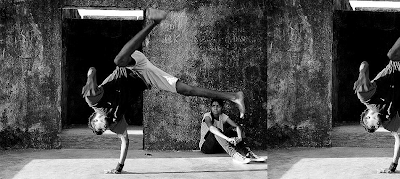By Mohini Varma, Account Planning Director (JWT Gurgaon)
The low, familiar
beats of bass, the rhythm of rap and the cadence of language. Walls splattered
with neon codes, graffiti signed off by the now familiar “Daku” on Delhi’s streets and signatures that herald members of the
‘hood’.
Step in to Dharavi,
Mumbai’s largest slum or the Khirkee Village in Delhi and you will sense a
‘vibe’ that is almost palpable – youngsters spin and get down to the Hip-Hop
beat, they celebrate a new found passion that offers them a ticket to express
freely, make a mark and set themselves apart. The spirit behind this new
movement is the compulsion to move beyond poverty and to break open the
limitations of life.
Khirkee Park Jam ,
Khoj Dus Tak Festival.Source: tinydrops.org ; AFP
The seeds of this
movement were sown by B-Boy Heera, now 30 and living in Delhi, who honed his
moves growing up in Queens, New York. According to a recent interview by the
AFP, Heera moved back to India in the 2000s and while visiting Dharavi with a
friend, Heera realized that the youth of Dharavi needed an outlet for the swell
of stemmed energy they carried within themselves. That belief led him and his
friend Akku to set up ‘Slumgods’, which now has 40 to 50 core members, across
the cities of Mumbai, New Delhi, Bangalore and Dharmashala. The crew works
hand-in-hand with Tiny Drops, a non-profit group founded by Heera in Dharavi
and his Delhi neighbourhood, to let kids explore the world of Hip-Hop.
Sion
Hillock Fort, Mumbai. Source: tinydrops.org; AFP
In Mumbai, the crumbling ruins of Sion Hillock Fort is the Slum Gods’ den. Today the fort stands tall as the new bastion for self-expression, an open space for the youth to connect, encourage and express to their hearts content.
Historically, Hip-Hop has been a product of cultural
integration, with definitive origins at the Bronx in New York around the late
1950s and with firm roots within African cultural history and oral traditions. All-encompassing
in its sway from fashion, music and a way of life, it’s free flowing and
adaptive nature points to a genealogy that is hardly linear but one that spans
cross- cultural influences. Its continuous development, over the years,
reflects a trajectory of give and take, where aspects of cultural specificity
are seamlessly woven into the basic fabric of the genre.The sway of Hip-Hop culture hit India
during the 80s and since then it has made a radical space for itself combining
indigenous influences along the way. The ‘Baraat’ and the free styling of the
1980 Bollywood heroes especially the likes of “Mithun da”and ‘Govinda’ reflect
an inherent alignment towards break-dancing. But the streets are where this
urban underground movement really thrives, here talent is raw and passion is prime.
For some, Hip – Hop inspires to keep life
simple and addiction free for others it’s a source of empowerment and an outlet
for bottled passions. However, while the Hip- Hop movement in India continues
to spread, there are a few daunting questions that need answers – Will Hip–Hop
for the disadvantaged youth in India offer integration or further alienation?
Will notions of identity bear further complexities? And more importantly will
this passion shape a better future, from a socio-economic point of view, for
the generations to come?
The answers may lie in the future, but a
simple recognition of the sheer passion that drives this burgeoning movement
could create a constructive road-map for this spirited subculture to grow,
empower and ultimately thrive within the streets of India.



No comments:
Post a Comment